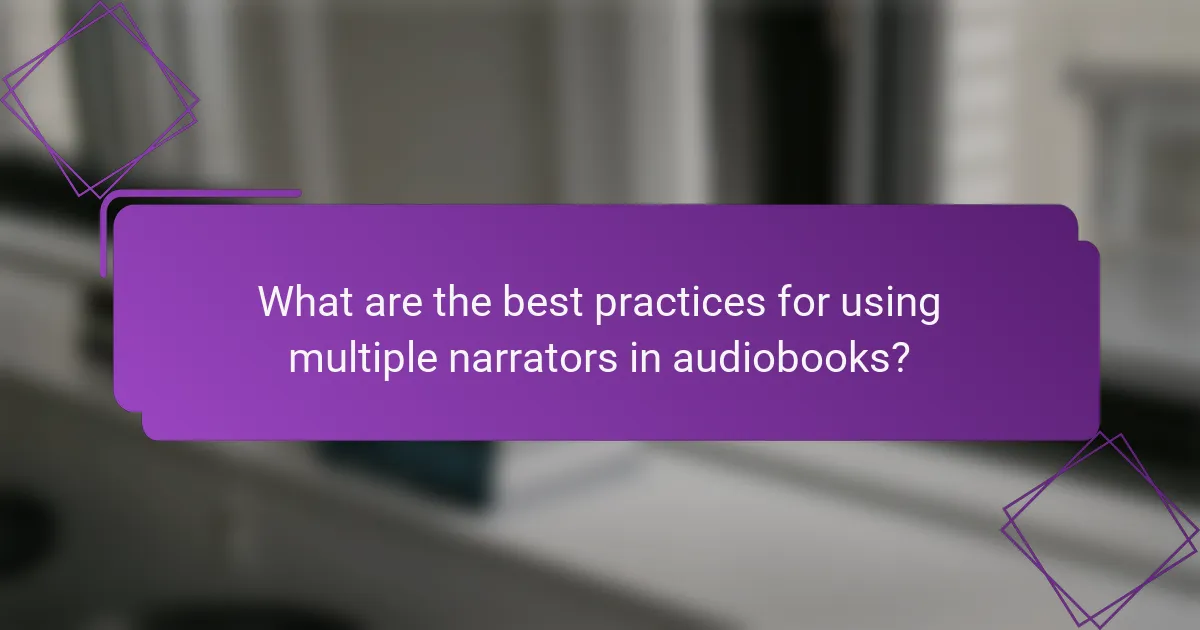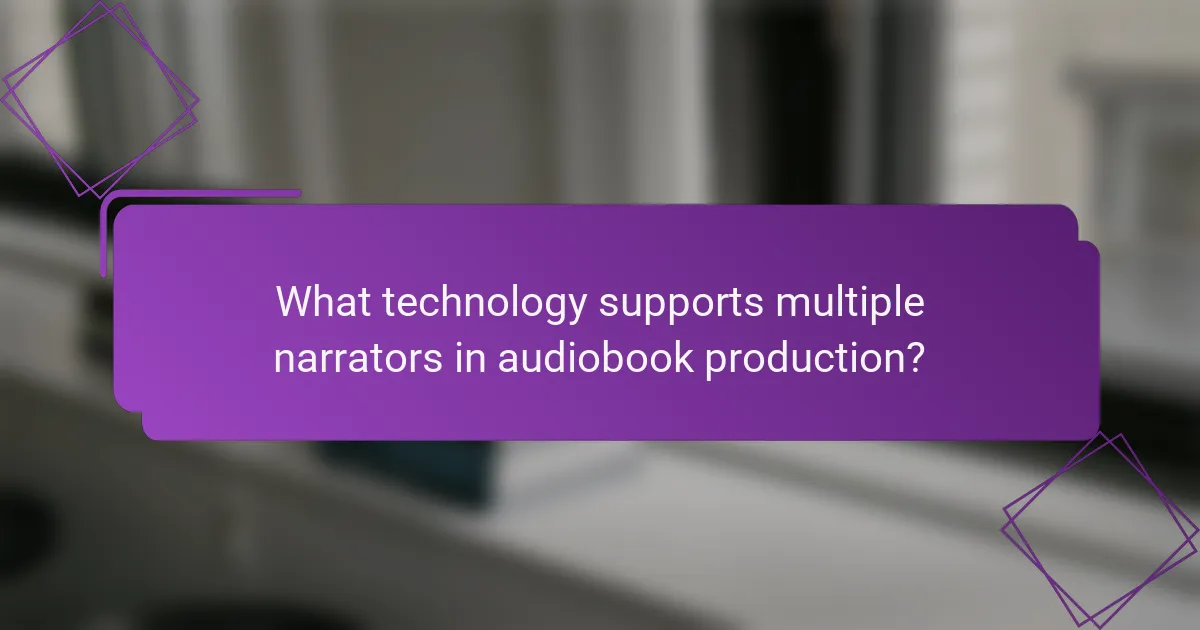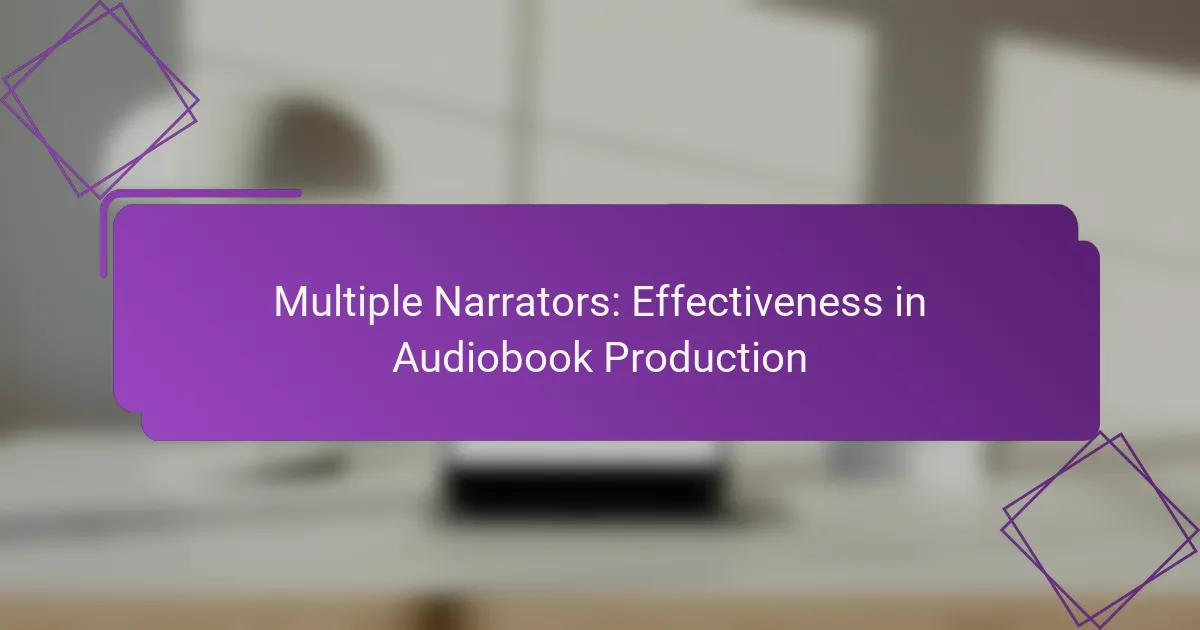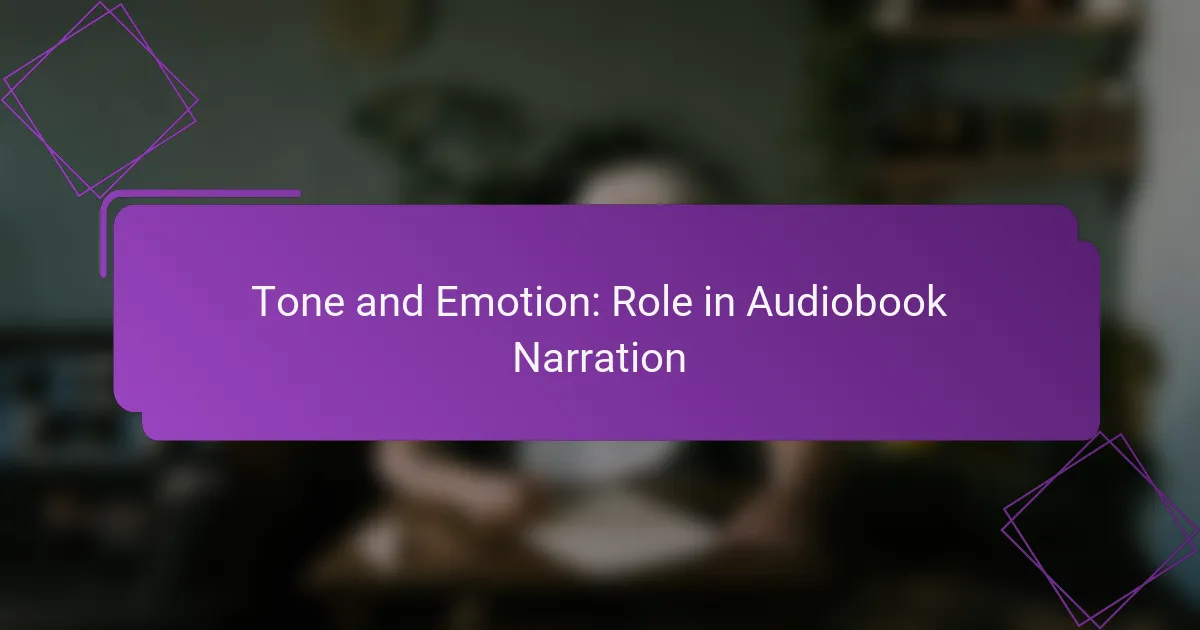Multiple narrators in audiobook production significantly enhance the listening experience by offering unique voices that embody various characters and perspectives. This approach not only fosters a deeper emotional connection with the story but also creates a more immersive atmosphere, making complex narratives more engaging for listeners.

How do multiple narrators enhance audiobook engagement?
Multiple narrators enhance audiobook engagement by providing distinct voices that bring characters and narratives to life. This technique fosters a deeper connection with the story, making it more immersive and enjoyable for listeners.
Increased emotional depth
Using multiple narrators allows for a richer emotional experience, as each voice can convey unique feelings and tones. For instance, a character’s sorrow can be expressed more poignantly by a narrator who specializes in conveying sadness, while another might excel at portraying joy.
This emotional layering can help listeners resonate with the characters on a personal level, leading to a more impactful storytelling experience. Audiobooks that utilize this technique often leave a lasting impression, encouraging repeat listens.
Varied character perspectives
Multiple narrators can effectively represent different character perspectives, allowing listeners to experience the story through various lenses. This approach can highlight contrasting viewpoints and motivations, enriching the narrative complexity.
For example, a story told from both a hero’s and a villain’s perspective can create a more nuanced understanding of the plot. This technique not only keeps the audience engaged but also encourages them to think critically about the characters’ choices and actions.
Dynamic storytelling experience
A dynamic storytelling experience is achieved when multiple narrators bring their unique styles to the audiobook. This variation can keep listeners captivated, as the shifts in voice and tone create a more theatrical experience.
Incorporating sound effects or background music alongside different narrators can further enhance this dynamic quality. Audiobook producers should consider these elements to maintain listener interest and provide a memorable auditory journey.

What are the best practices for using multiple narrators in audiobooks?
Using multiple narrators in audiobooks can enhance the listening experience by providing distinct voices for different characters or perspectives. To achieve this effectively, it is crucial to consider narrator selection, voice balance, and pacing consistency.
Choosing the right narrators
Selecting the appropriate narrators is essential for creating an engaging audiobook. Look for individuals whose vocal qualities align with the characters they will portray, ensuring that their delivery matches the tone of the story. Consider factors such as accent, age, and emotional range when making your choices.
It’s beneficial to conduct auditions or listen to samples of potential narrators. This allows you to assess their ability to convey the story’s nuances and connect with the audience. Aim for a diverse range of voices to represent different characters authentically.
Balancing narrative voices
Balancing the narrative voices is vital to maintain coherence throughout the audiobook. Each narrator should have a distinct style, but their performances must complement one another to avoid jarring transitions. Establish a clear guideline for how each character should sound and interact with the narrative.
Consider using a primary narrator for the main storyline while assigning secondary narrators for character dialogues or subplots. This approach can create a dynamic listening experience while keeping the story cohesive. Regular communication among narrators during recording sessions can help achieve this balance.
Maintaining consistent pacing
Consistent pacing is key to ensuring a smooth flow in an audiobook with multiple narrators. Each narrator should adhere to a similar tempo to prevent abrupt changes that could disrupt the listener’s experience. Establish a shared understanding of the pacing before recording begins.
Utilizing a metronome or pacing guide can help narrators stay aligned. Additionally, post-production editing can assist in adjusting any discrepancies in speed. Regularly reviewing the recordings as a group can also provide insights into pacing adjustments needed for a unified final product.

Which audiobooks effectively utilize multiple narrators?
Audiobooks that effectively utilize multiple narrators often enhance the storytelling experience by providing distinct voices for different characters or perspectives. This technique can create a more immersive and engaging listening experience, particularly in complex narratives or character-driven stories.
The Night Circus by Erin Morgenstern
“The Night Circus” features multiple narrators who bring to life the enchanting and mysterious world of the circus. Each narrator represents a different character, allowing listeners to experience the story from various viewpoints, which deepens emotional engagement. The interplay between the narrators also mirrors the novel’s themes of competition and magic.
When considering this audiobook, pay attention to how the distinct voices enhance the atmosphere and character development. The varied pacing and tone can significantly affect the listener’s connection to the story.
Good Omens by Neil Gaiman and Terry Pratchett
“Good Omens” employs multiple narrators to capture the humor and whimsy of its apocalyptic tale. The contrasting styles of the narrators effectively highlight the quirky personalities of the characters, making the narrative more dynamic and entertaining. This approach allows listeners to appreciate the satirical elements of the story more fully.
For those interested in this audiobook, note how the use of different narrators can amplify comedic timing and character interactions. It’s a great example of how voice variety can enhance storytelling in a light-hearted context.
The Help by Kathryn Stockett
“The Help” utilizes multiple narrators to present the perspectives of three women during the Civil Rights Movement in the United States. Each narrator brings her own unique voice and experiences, which enriches the narrative and provides a deeper understanding of the social issues at play. This technique allows listeners to grasp the complexities of race and gender in that era.
When engaging with this audiobook, consider how the varied perspectives contribute to the overall message and emotional weight of the story. The distinct voices help to personalize the historical context, making it more relatable and impactful for the audience.

What are the challenges of multiple narrators in audiobook production?
Multiple narrators in audiobook production can enhance storytelling but also present several challenges. Key issues include coordination and scheduling, maintaining audio quality, and ensuring consistent character portrayal across different narrators.
Coordination and scheduling issues
Managing multiple narrators requires careful planning and coordination. Each narrator may have different availability, which can complicate recording sessions and lead to delays. It’s essential to create a detailed schedule that accommodates all participants to minimize disruptions.
Using project management tools can help streamline this process. Clearly defined timelines and deadlines for each narrator can ensure that everyone stays on track. Regular check-ins can also help address any scheduling conflicts early on.
Maintaining audio quality
Ensuring consistent audio quality across different narrators is crucial for a seamless listening experience. Variations in recording equipment, voice modulation, and background noise can affect the overall sound. It’s important to establish clear audio standards and guidelines for all narrators to follow.
Consider conducting initial tests with each narrator to calibrate sound levels and identify any potential issues. Using the same recording studio or equipment can also help maintain uniformity in audio quality throughout the production.
Potential for inconsistent character portrayal
Different narrators may interpret characters in varied ways, leading to inconsistencies in portrayal. This can confuse listeners and detract from the story’s coherence. To mitigate this, provide detailed character descriptions and context to each narrator before recording.
Encouraging narrators to listen to each other’s performances can foster a more unified interpretation. Regular feedback sessions can also help align their portrayals, ensuring that character voices remain consistent throughout the audiobook.

How does audience preference influence narrator selection?
Audience preference plays a crucial role in narrator selection for audiobooks, as it directly impacts listener engagement and satisfaction. Understanding what listeners enjoy can guide producers in choosing narrators who resonate with their target demographic and genre.
Demographic considerations
Demographics such as age, gender, and cultural background significantly influence narrator selection. For instance, younger audiences may prefer narrators with contemporary styles, while older listeners might favor classic, traditional voices. Producers should analyze their target audience to align narrator characteristics with listener expectations.
Additionally, regional accents and dialects can enhance relatability for specific demographics. For example, a British narrator may appeal more to listeners in the UK, while an American narrator might be preferred in the US.
Genre-specific preferences
Different genres often come with distinct listener expectations regarding narration style. For example, romance audiobooks may benefit from narrators who can convey emotion and intimacy, while thrillers might require a more dramatic and suspenseful delivery. Understanding these nuances helps producers select narrators who can effectively enhance the storytelling experience.
Moreover, genre popularity can shift over time, influencing narrator choices. Staying updated on trends can help producers select narrators that align with current audience preferences in various genres.
Listener feedback and reviews
Listener feedback is a valuable resource for assessing narrator effectiveness. Reviews often highlight specific aspects of a narrator’s performance, such as clarity, pacing, and emotional delivery. Producers should actively seek and analyze this feedback to refine their narrator selection process.
Incorporating listener preferences into future projects can lead to improved satisfaction and increased sales. Regularly monitoring platforms where audiobooks are reviewed can provide insights into what works and what doesn’t, guiding future narrator choices effectively.

What technology supports multiple narrators in audiobook production?
Multiple narrators in audiobook production are supported by various technologies that enhance audio quality and streamline the editing process. Key tools include advanced audio editing software, which allows for seamless integration of different voices, and recording equipment that captures high-fidelity sound.
Advanced audio editing software
Advanced audio editing software is crucial for managing multiple narrators in audiobook production. Programs like Adobe Audition, Audacity, and Pro Tools enable editors to layer different audio tracks, adjust volume levels, and apply effects to ensure a cohesive listening experience.
When selecting software, consider features such as multi-track editing, noise reduction, and real-time collaboration tools. These capabilities can significantly reduce the time spent on post-production, allowing for a more efficient workflow.
Common pitfalls include neglecting to balance audio levels between narrators and failing to edit for pacing and clarity. Regularly using audio meters and listening tests can help maintain quality across different voices.



